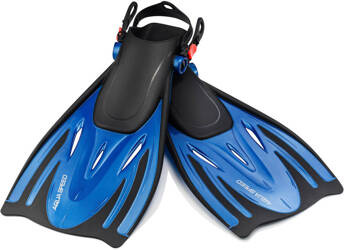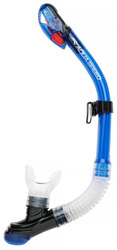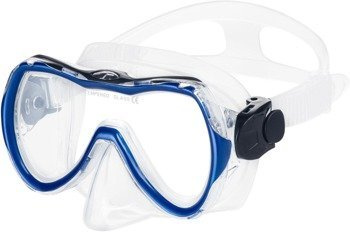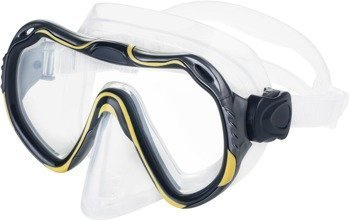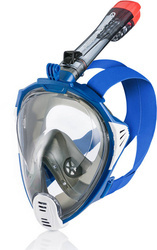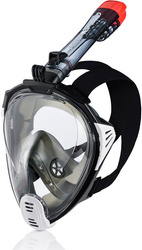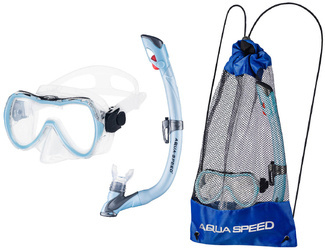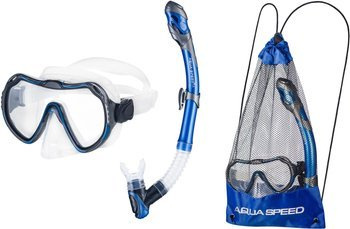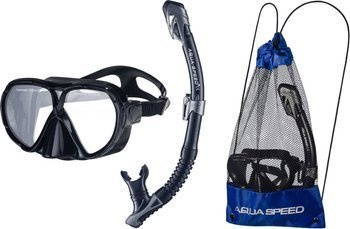How to Choose a Diving Mask?
The most important feature of a good diving mask is its tight fit to the face. Therefore, the first thing to do when selecting or purchasing this accessory is to try it on properly. What does this mean?
- A diving mask must fit snugly to the face without securing it with the strap on the head.
- Once the mask is in place, inhale through your nose—it should suction onto your face. Then, tilt your head downwards (as if swimming); the mask should remain in place throughout the breath-holding period.
- The nose should not touch the mask. Check if you can easily pinch your nose with your fingers.
- The silicone skirt must seal against the face evenly around the entire edge. Any leaks should be adjustable with the strap. If adjustment doesn’t resolve the issue, you’ll need to look for another diving mask.
What Snorkel to Choose as a Beginner?
Breathing through a snorkel can be a bit challenging at first—it takes some getting used to. For this reason, it’s best to choose snorkels with a soft, anatomically shaped mouthpiece that fits well inside the mouth without needing to be gripped tightly by the teeth.
A good snorkel should have special valves (bottom and top) that serve two purposes:They allow water accidentally drawn into the snorkel to be easily expelled. They prevent water from entering during full submersion or while performing various movements underwater. For example, Aqua Speed snorkels with top valves guarantee safe diving up to 3.5 meters without the risk of water entering the tube.
The color of the snorkel isn’t particularly important for deeper diving, but it can be helpful as a visual marker for locating a snorkeler swimming at shallow depths. If the snorkel is a subdued color (blue, navy, steel, etc.), ensure that at least the tip is brightly colored for visibility.
Which Fins Are Best to Choose?
There are two types of fins available on the market: full-foot fins and open-heel fins. The main difference lies in how they are worn: Full-foot fins are always worn directly on bare feet. Open-heel fins require diving boots and are worn over them.For beginners, open-heel fins are recommended, as they don’t put pressure on the feet. It’s also worth investing in good-quality fins, especially at the start of your diving journey. Higher-quality fins not only enable faster swimming but also enhance underwater safety.
Water Shoes
When planning a holiday by the water with underwater adventures in mind, it's worth equipping yourself and your loved ones with so-called water shoes.
These lightweight, flexible footwear options are made from elastic materials, making them easy to pack in a carry-on bag. They can be used anywhere comfortable, quick-drying, and protective shoes are needed.
Water shoes are great for hotel spas, beach walks, casual bike rides, gym sessions, or yoga classes. However, they were primarily designed for water sports such as windsurfing, kayaking, stand-up paddleboarding (SUP), or snorkeling.
They perform particularly well for snorkeling enthusiasts exploring the underwater world, especially near the shore where they may need to walk in unfamiliar waters, over rocks, or in areas with sharp or slippery stones, sea urchins, sharp shells, gravel, cans, bottles, or other hazardous debris.
Thanks to their unique design and lightweight construction, these shoes are a versatile addition to any vacation suitcase.
The article was published in the eighth issue of AQUA SPEED Magazine. AQUA SPEED Magazine is all about fantastic people and their swimming adventures. It provides tips and advice on training, competing in events, and spending time by the water in an active and safe way.







